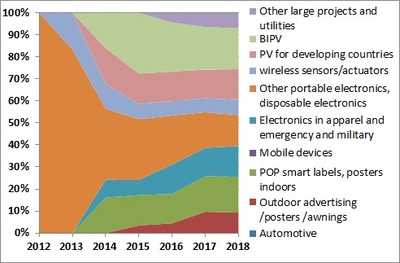Forecasts for third-generation solar technology
Friday, 10 May, 2013
The PV industry slowdown may have negatively impacted the market for dye-sensitised solar cells (DSSCs) but the future doesn’t look quite so grim. Market research firm IDTechEx forecasts the DSSCs market to grow to over $130 million by 2023.
The market for dye-sensitised solar cells (DSSCs) is forecast to slowly grow to over US$130 million by 2023 according to market research company IDTechEx's recently released report ‘Dye Sensitized Solar Cells (DSSC/DSC) 2013-2023: Technologies, Markets, Players’.
Although initial products are aimed towards indoor, portable applications such as solar chargers, solar bags and solar wireless keyboards, the end game for DSSCs is the ability to have these largely inexpensive solar cells incorporated into a wider variety of product offerings, including larger installations. For that purpose, development work is being undertaken in order to produce prototypes and demonstrators of DSSCs being utilised in applications such as bus shelters, steel roofing and others such as facades, semi-transparent windows, etc.
As can be seen from the chart below, in the next few years applications for portable electronics will remain the most popular application in which DSSCs will be deployed but, in later years, the scene is going to change. A larger share will be taken over by applications such as smart labels, the currently nascent sector of energy harvesting for wireless sensor networks, as well as applications in photovoltaics (PV) for developing countries and building integrated solutions. As described in more detail in the report, mobile electronics and automotive integration will remain limited, mainly due to the power output demands for these demanding but also cost-sensitive market segments.

Established players and new entrants
The difficulties in the PV industry in recent years have had their impact on dye-sensitised solar cells, the slow growth of the market for the technology being testimony to the effects of the PV industry slowdown. With DSSC technology being part of a third generation of PV devices, the market conditions have been especially challenging.
Regardless of this fact, there has been activity that showcases that developments in the DSSC industry are continuing: established companies such as Dyesol continue their work on large-scale installations in collaboration with Tata Steel in North Wales. G24 Innovations, after going into administration a few months ago, is now under new management and has renamed itself G24i Power, continuing its commercialisation efforts. NLAB has also been revamped and is now called Exeger and, having received a US$20 million investment, is proceeding with building a 20 MW production line in Stockholm, Sweden, in which they will further develop their DSSCs incorporating their proprietary 1DPC (one-dimensional photonic crystal) technology.
Earlier in the value chain, Solaronix is still one of the best established materials providers for DSSCs but is also currently involved in the manufacture of DSSC modules, which will be utilised in a facade commissioned by the EPFL in Lausanne, planned to be completed at the end of 2013. As a newer entrant, Dyenamo of Sweden is focusing on developing innovative material solutions but also offers design and integration services, ‘samples on demand’ and consultancy services to their customers.
Finally, it’s not just European companies pushing ahead with DSSC developments. Although multinational giants Sharp and Sony seem to be winding down their DSSC operations and are focusing on other products, Nissha Printing in Japan is actively engaged with further developing its proprietary EneLEAF DSSC technology, while CSIRO in Australia recently became part of a consortium that has been given funding for an US$80 million, eight-year project to create a joint Australia-USA research centre on advanced photovoltaics. The lead partner is the University of New South Wales but it includes all of the major research groups working on PV in Australia.
Australia's largest electronics expo returns to Sydney
Electronex, the annual electronics design and assembly expo, will return to Sydney on 19–20...
The fundamentals of Australian RCM compliance
The following information aims to help readers understand the Australian compliance requirements...
Largest ever Electronex Expo in Melbourne
The Electronics Design and Assembly Expo will return to Melbourne from 10–11 May at the...






